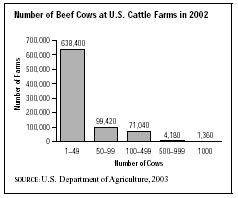SIC 0219
GENERAL LIVESTOCK, EXCEPT DAIRY AND POULTRY
This classification covers establishments deriving 50 percent or more of their total value of sales or agricultural products from livestock such as cattle, hogs, sheep, and goats, but with less than 50 percent deriving from any single one of those livestock categories.
NAICS Code(s)
112990 (All Other Animal Production)
The multi-faceted, diversified livestock farm had faded from the American landscape by the early 2000s because of industry emphasis on specialization. Large farms focused on raising a single animal were poised to all but replace diversified farms and ranches by the end of the twentieth century. Cattle production, for example, grew into an enormous industry. In the early 2000s, the industry was valued at $70 billion. Additionally, although only 1,360 of the 814,400 U.S. cattle farms had more than 1,000 cows in 2002, these farms accounted for roughly one-third of the country's cattle production and an even larger percentage of cattle value. Cattle farms with less than 100 head of cattle continued to decline in both number of farms and in dollar value production. Overall, the number of beef cattle farms dipped by 2 percent in 2002.
Farmers grazed herds on harvested crop land, which made cattle raising a lucrative side-business. Many

smaller farms were able to support small-to moderate-sized herds this way.
Like the cattle industry, many hog producers became increasingly larger operations as well. In this $11 billion industry, liberal production laws in states such as North Carolina have attacked large corporate hog farms, but the trend in hog production favors the growth of large-scale organizations. The number of farms that sold more than 5,000 hogs and pigs accounted for roughly 80 percent of total hog output by 2003. This does not mean that ranchers and farmers have given up on diversifying their operations. The species of livestock and the character of the business have changed, though, over the years, and those establishments that fit in this classification are apt to be small family-run outfits. The number of these small operations continued to decline throughout the early 2000s.
Nevertheless, several of the larger beef cattle operations have made some moves toward diversification. Some are also involved in the raising of horses. With the growing popularity of team penning, cutting, roping, and other equine recreational sports, the sale of working ranch horses has become an important source of income for a number of smaller ranches.
Historically, cattle and sheep bred in America did not graze the same land; indeed, cattlemen and sheep-herders often viewed each other as rivals. This has changed, however, as studies have indicated that running cattle and sheep together helps keep predators at bay. Sheepherders now believe that coyotes are intimidated when cattle are present, thus drastically cutting sheep losses. Running the two species together is also becoming popular for another reason. Overgrazing of plant species is decreased because the cattle eat the grasses while the sheep eat broad-leafed weeds, forbes, and shrubs. Running the two species together is thus a growing phenomenon in parts of the country to both protect the livestock and the land.
Further Reading
Today's U.S. Pork Industry. Des Moines, IA: National Pork Producers Council (NPPC), 2004. Available from http://www.nppc.org/about/pork_today.html .
United States Department of Agriculture, National Agricultural Statistics Service. "Statistics of Cattle, Hogs, and Sheep." Washington, D.C.: 2002. Available from http://www.usda.gov/nass/pubs/agr01/01_ch7.pdf .
Comment about this article, ask questions, or add new information about this topic: